How Long Does Fresh Salsa Last
Fresh salsa's shelf life depends on your storage method and whether it's homemade or store-bought. Your homemade salsa will last 4-7 days when stored properly in an airtight container in the refrigerator at 35-40°F. Store-bought varieties last longer: unopened containers remain fresh for 12-18 months at room temperature or 2-4 weeks refrigerated, while opened containers stay good for 1-2 weeks in the fridge. You'll know your salsa's spoiled if you notice an unpleasant odor, mold, texture changes, or color alterations. To maximize your salsa's freshness, proper storage techniques and handling practices make all the difference.
This post may contain affiliate links. If you make a purchase through these links, I may earn a commission at no additional cost to you. Additionally, portions of this post may be generated using artificial intelligence (AI) technology. While we strive for accuracy, please be aware that AI-generated content may not always be perfect and should be fact-checked when necessary.
The Spatula Scoops
- Homemade fresh salsa typically lasts 4-7 days when stored in an airtight container in the refrigerator below 40°F.
- Store-bought salsa remains fresh for 1-2 weeks after opening when properly refrigerated.
- Fresh salsa should be discarded if it develops mold, unpleasant odors, unusual texture changes, or discoloration.
- Adding acidic ingredients like lime juice or vinegar can extend fresh salsa's shelf life by 1-2 additional days.
- Fresh salsa left at room temperature for over 2 hours should be discarded due to potential bacterial growth.
Storage Methods for Fresh Salsa
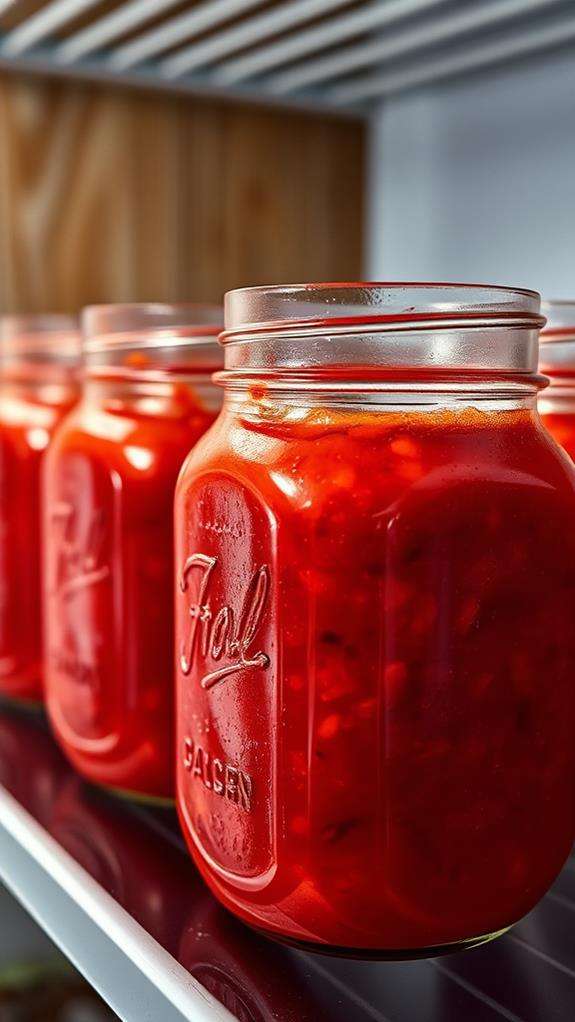
Three main storage methods can keep your fresh salsa in perfect condition: refrigeration, freezing, and vacuum sealing.
Refrigeration is your primary storage option, requiring an airtight container and a consistent temperature between 35-40°F. You'll want to place your salsa in the main compartment of your fridge, not the door, where temperature fluctuations occur more frequently. For freezing, you'll need to transfer your salsa to freezer-safe containers, leaving about ½ inch of headspace to allow for expansion. While freezing extends shelf life considerably, it's essential to highlight that the texture may change slightly upon thawing.
Vacuum sealing offers the most professional preservation method, removing air that can lead to oxidation and bacterial growth. You'll need a vacuum sealer and compatible bags or containers. When using this method, you can portion your salsa into serving sizes before sealing, making it convenient for future use. To maintain ideal freshness, label your containers with the preparation date and storage method used, regardless of which technique you choose. This practice helps you track freshness and guarantees you're using the salsa within its safe consumption window.
Signs of Spoiled Salsa
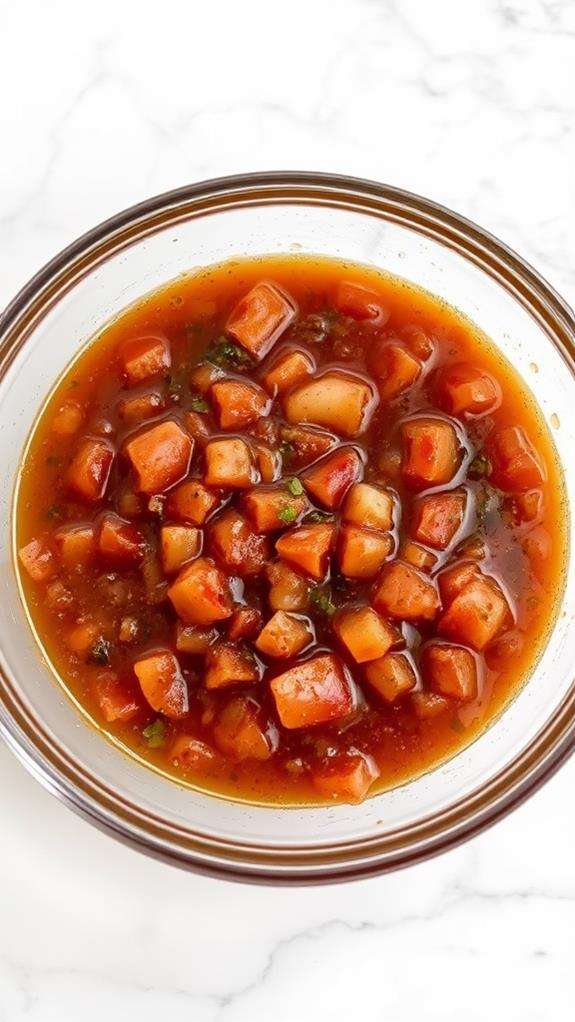
Several telltale signs indicate your fresh salsa has spoiled. When you notice a sour or unpleasant odor that's different from the fresh, vibrant scent of tomatoes and cilantro, it's time to discard your salsa. You'll also want to look for any signs of mold, which can appear as white, green, or black spots on the surface or along the container's edges.
The texture and color changes are equally important indicators of spoilage. If you see liquid separation that doesn't remix easily, or if the vegetables have become mushy and lost their distinct shapes, your salsa's likely gone bad. Fresh salsa should maintain its bright, vivid colors – when you notice the tomatoes turning darker or the overall appearance becoming dull and brownish, that's another warning sign.
Don't ignore changes in taste, either. If your salsa develops an unusually tangy, bitter, or fermented flavor, it's past its prime. You might also notice bubbling or fizzing, which indicates fermentation has begun. When in doubt, remember the food safety motto: "If in doubt, throw it out."
Homemade Vs Store-Bought Shelf Life

While knowing the signs of spoilage helps you identify bad salsa, understanding the shelf life differences between homemade and store-bought varieties can help prevent waste in the first place.
Store-bought salsa typically contains preservatives and undergoes commercial processing methods, extending its shelf life considerably. You'll find that unopened, shelf-stable store-bought salsa can last 12-18 months in your pantry, while refrigerated varieties last 2-4 weeks when sealed. Once opened, both types will stay fresh for 1-2 weeks in your refrigerator.
Homemade salsa, however, has a much shorter lifespan since it lacks commercial preservatives and pasteurization. When stored properly in an airtight container in your refrigerator, fresh homemade salsa typically lasts 4-7 days. If you've added acidic ingredients like lime juice or vinegar, you might get an extra day or two of freshness. For maximum shelf life, you'll want to store your homemade salsa in a glass container rather than plastic, as glass doesn't absorb odors or stains and maintains a more stable temperature. The ingredients you use also affect longevity – salsa made with fresh tomatoes won't last as long as those made with canned tomatoes.
Refrigeration and Temperature Guidelines
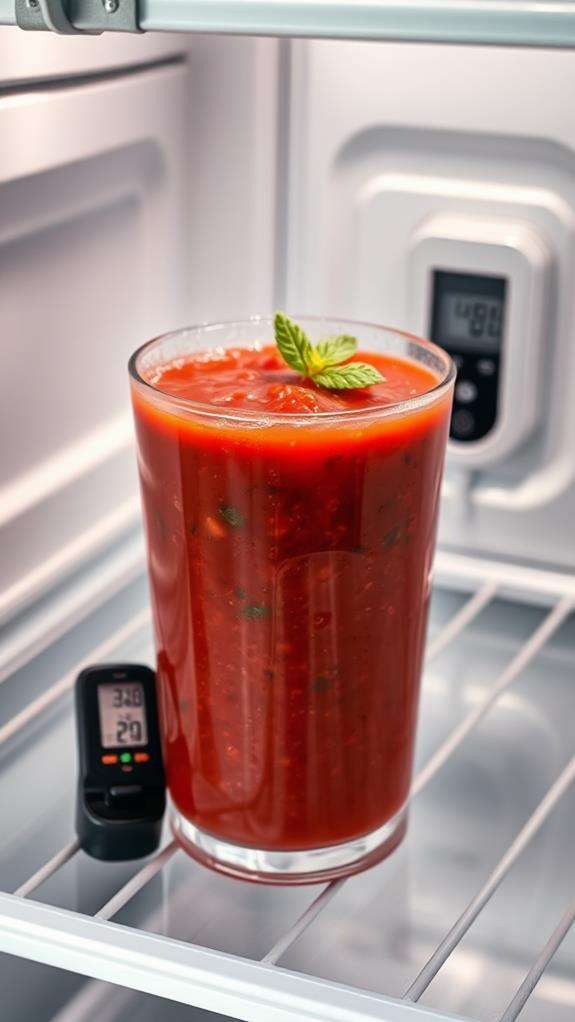
Proper temperature control stands at the heart of keeping your salsa fresh and safe to eat. You'll want to maintain your refrigerator's temperature between 35°F and 40°F (1.7°C to 4.4°C), with 38°F being the best storage temperature for fresh salsa. Don't let your salsa sit out at room temperature for more than 2 hours, as bacteria multiply rapidly in the "danger zone" between 40°F and 140°F.
When you're storing your salsa, place it in an airtight container and keep it toward the back of your refrigerator, where temperatures remain most consistent. You should avoid storing it in the door, as temperature fluctuations occur each time you open and close it. If you're transferring store-bought salsa to another container, make sure it's completely clean and dry to prevent contamination.
For peak freshness, you'll need to monitor your refrigerator's temperature regularly using a reliable thermometer. If you've made a large batch of salsa, consider dividing it into smaller portions. This way, you'll only need to remove what you plan to use, keeping the rest properly chilled and reducing exposure to warmer temperatures.
Extending Your Salsa's Freshness

To maximize your salsa's shelf life, you can implement a few practical strategies beyond basic refrigeration. You'll want to focus on proper storage techniques and handling methods that prevent bacterial growth and maintain ideal freshness.
- Store your salsa in an airtight glass container rather than plastic, as glass won't absorb odors or stains and provides better temperature stability
- Remove excess air from the container before sealing, which reduces oxidation and helps prevent the growth of harmful microorganisms
- Keep your salsa in the back of the refrigerator where temperature remains most consistent, avoiding the door area where fluctuations occur
- Use clean utensils each time you serve the salsa, preventing cross-contamination that can accelerate spoilage
You can also extend your salsa's freshness by choosing high-quality, firm vegetables and removing excess moisture before mixing ingredients. If you're working with tomatoes, consider removing the seeds and pulp, as these components contain extra water that can lead to faster deterioration. When you're adding acidic ingredients like lime juice or vinegar, make sure they're evenly distributed throughout the mixture, as they act as natural preservatives that help maintain freshness.
Common Ingredients Impact Duration
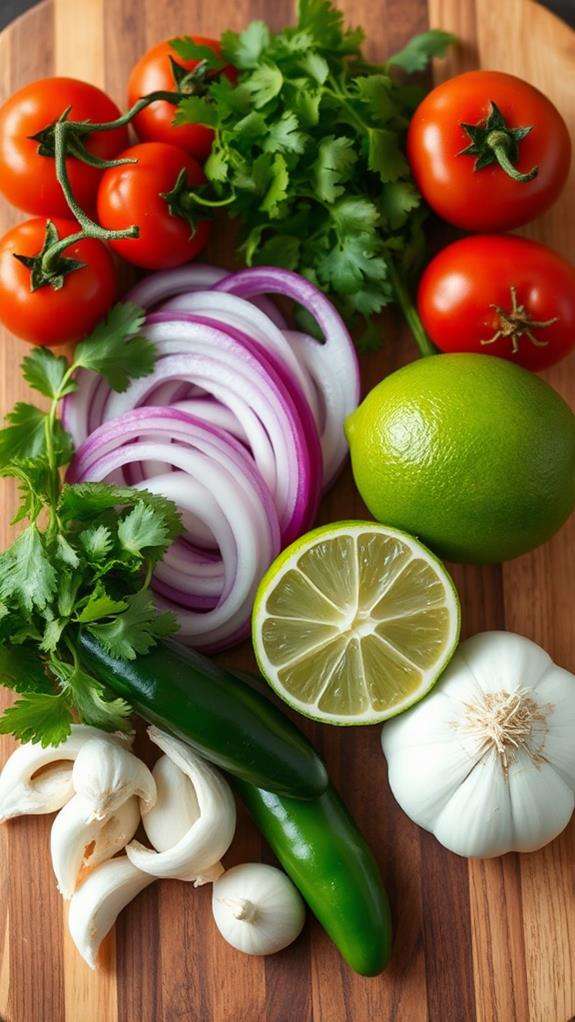
Different ingredients in your salsa recipe can greatly affect how long it stays fresh. You'll find that acidic ingredients like lime juice and vinegar act as natural preservatives, while water-rich vegetables can speed up spoilage. Understanding each component's impact will help you maximize your salsa's shelf life.
| Ingredient Type | Impact on Freshness |
|---|---|
| Acidic (citrus, vinegar) | Extends shelf life by 1-2 days |
| Watery (tomatoes, cucumber) | Reduces freshness, increases separation |
| Alliums (onions, garlic) | Natural antimicrobial properties |
When you're making fresh salsa, you'll want to reflect on how each ingredient affects storage time. Fresh tomatoes contain high water content and will begin breaking down after 24 hours, but adding lime juice helps combat this process. You'll notice that onions and garlic contribute antimicrobial properties that can help preserve your salsa, though they'll become stronger in flavor over time. If you're using delicate herbs like cilantro, they'll be the first to show signs of wilting, typically within 1-2 days. For best results, you should balance water-heavy ingredients with natural preservatives.
Safe Handling and Storage Tips
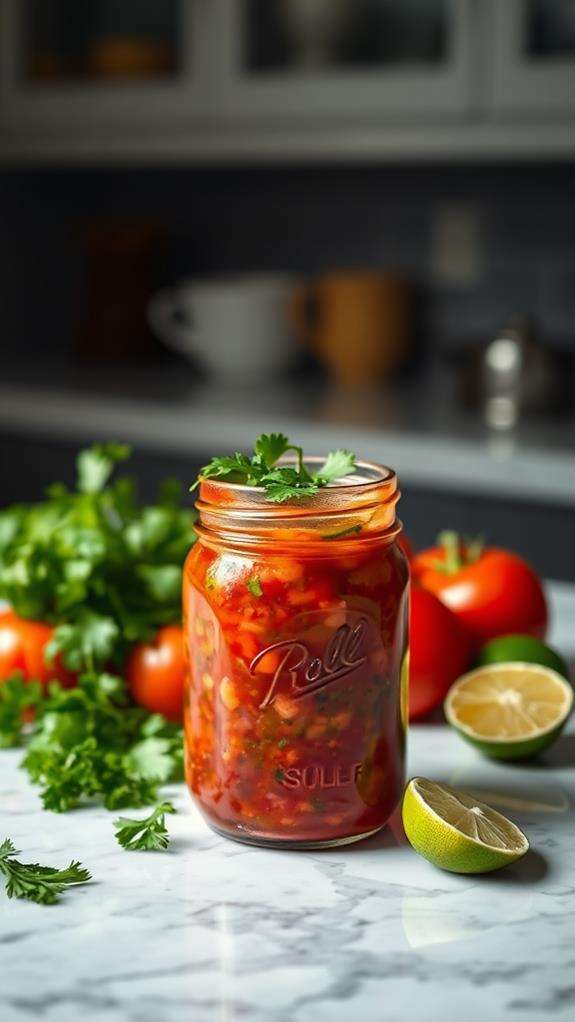
To keep your fresh salsa safe and flavorful, you'll want to start by washing all your prep equipment and containers with hot, soapy water, ensuring there's no lingering bacteria or residue. When selecting storage containers, choose airtight glass or food-grade plastic vessels with secure-fitting lids that'll prevent cross-contamination and maintain freshness. After preparing your salsa, you must refrigerate it immediately at a temperature below 40° F, which helps inhibit bacterial growth and extends the salsa's shelf life.
Clean Equipment First
Before diving into salsa preparation, properly cleaning your equipment is essential for food safety and longer shelf life. You'll want to make sure that every utensil, cutting board, and container is thoroughly sanitized to prevent bacterial growth and cross-contamination, which can greatly reduce your salsa's shelf life.
Follow these critical steps to properly clean your equipment:
- Wash all utensils and containers with hot, soapy water, making sure to scrub thoroughly to remove any residue or food particles
- Sanitize cutting boards and preparation surfaces with a solution of 1 tablespoon bleach per gallon of water
- Rinse everything thoroughly with clean, hot water to remove all cleaning agents
- Dry all equipment completely with clean paper towels or let air dry, as moisture can promote bacterial growth
You'll need to pay special attention to cutting boards, which can harbor bacteria in their knife marks and grooves. If you're using wooden utensils or boards, make sure they're completely dry before use, as wood can retain moisture that promotes spoilage. Don't forget to clean your can opener if you're incorporating canned ingredients into your fresh salsa recipe.
Proper Container Selection
Selecting the right container goes a long way in preserving your fresh salsa's quality and extending its shelf life. You'll want to choose an airtight container made from food-grade materials, such as glass, BPA-free plastic, or stainless steel, that won't react with the acidic ingredients in your salsa.
Glass containers with snap-locking lids are your best option because they're non-porous, won't absorb flavors or odors, and they're easy to clean thoroughly. If you're using plastic containers, make sure they're specifically designed for food storage and don't have any scratches or damage that could harbor bacteria. The container should be appropriately sized for your salsa amount, leaving minimal headspace to reduce oxidation.
Don't use metal containers that aren't stainless steel, as the acids in tomatoes and citrus can react with the metal, affecting both taste and food safety. Your container should have a wide mouth for easy access and cleaning, and the lid should create a reliable seal. If you're planning to freeze your salsa, choose freezer-safe containers that allow for expansion during freezing.
Refrigerate Below 40° F
Maintaining proper temperature control is essential for keeping your fresh salsa safe to eat. Your refrigerator's temperature should consistently stay below 40°F (4°C) to prevent harmful bacteria growth and maintain the salsa's freshness. You'll want to check your refrigerator's temperature regularly using a reliable thermometer to guarantee ideal storage conditions.
Here's what you need to know about proper temperature control for your fresh salsa:
- Store your salsa immediately after preparation or opening in the main body of your refrigerator, not the door where temperatures fluctuate
- Don't let your salsa sit at room temperature for more than 2 hours (or 1 hour if the ambient temperature exceeds 90°F)
- Use an appliance thermometer to monitor your refrigerator's temperature daily
- Keep your salsa container on a shelf near the back of the refrigerator, where it's typically coldest
If you notice your refrigerator struggling to maintain temperatures below 40°F, you'll need to adjust the settings or have it serviced. Temperature abuse is a leading cause of foodborne illness, so you shouldn't take chances with proper refrigeration of your fresh salsa.
Frequently Asked Questions
Can You Freeze Fresh Salsa Without Affecting Its Texture?
You can freeze fresh salsa, but it won't maintain its original texture once thawed. The water content in vegetables, especially tomatoes, forms ice crystals during freezing, which breaks down their cellular structure. When you thaw the salsa, you'll notice it's more watery and the vegetables are softer. While it'll still be safe to eat and maintain its flavor, the crisp, fresh texture you're used to will be substantially altered.
Why Does Restaurant Salsa Taste Different From Homemade Salsa?
Studies show that 85% of restaurants use specific preparation techniques that set their salsa apart. You'll notice restaurant salsa often tastes different because they typically use roasted ingredients, commercial-grade equipment for consistent blending, and precise seasoning ratios. They'll also often add preservatives and stabilizers for longer shelf life, while using concentrated lime juice or citric acid instead of fresh citrus. Many restaurants also cook their tomatoes briefly, unlike most homemade versions.
Is It Safe to Can Homemade Salsa Without a Pressure Cooker?
You shouldn't can salsa without a pressure cooker or water bath canner, as it's not safe for low-acid foods like vegetables and tomatoes. The high temperatures needed to kill harmful bacteria, particularly botulism spores, can't be achieved through regular pot boiling. If you'd like to preserve salsa safely, you'll need either a pressure canner or water bath canner, and you must follow tested recipes with proper acid levels.
Can Pregnant Women Eat Fresh, Uncooked Salsa?
You should exercise caution with fresh salsa during pregnancy, as nearly 48% of foodborne illnesses come from raw produce. While you can eat fresh salsa, you'll need to guarantee it's properly prepared and stored. Make sure you're using thoroughly washed ingredients, storing it at 40°F or below, and consuming it within 24 hours of preparation. If you're dining out, it's safer to choose restaurant-made salsa that follows strict food safety guidelines.
Does Adding Lime Juice Change How Long Fresh Salsa Stays Good?
Yes, adding lime juice to your fresh salsa helps extend its shelf life due to the citric acid's natural preservative properties. You'll notice the lime juice's acidity creates an environment that slows bacterial growth. For best results, you'll want to add 1-2 tablespoons of fresh lime juice per cup of salsa. While it won't make your salsa last indefinitely, it can add 1-2 extra days of freshness when stored properly in the refrigerator.





